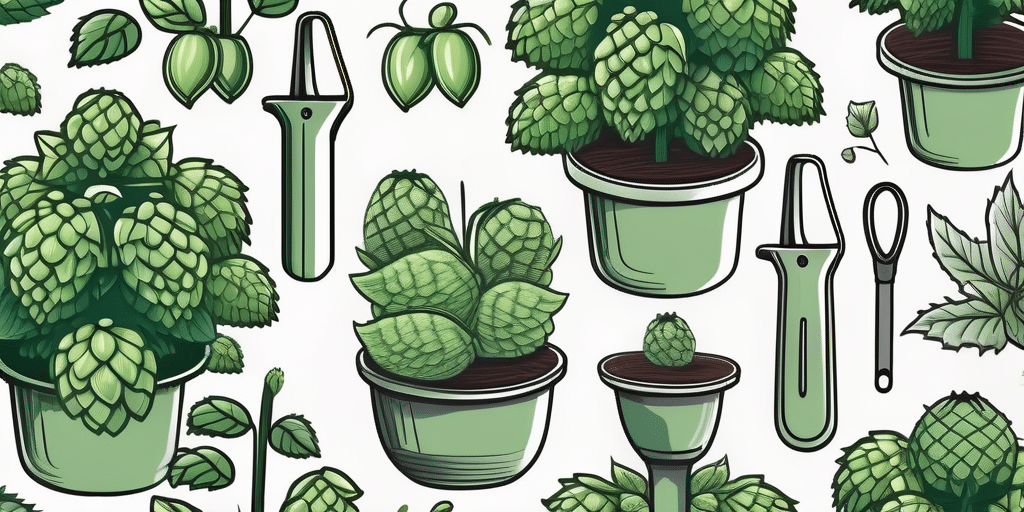Are you a coffee lover who dreams of growing your own coffee plant at home? Imagine the satisfaction of sipping your morning brew, knowing it came from your very own garden. In this ultimate guide, we will walk you through everything you need to know about successfully growing a coffee plant. From understanding the basics to caring for your plant, we’ve got you covered. Let’s dive in!
Understanding Coffee Plant Basics
Before you embark on your coffee-growing journey, it’s essential to familiarize yourself with the basics of coffee plants. Let’s explore the origin and history of coffee plants, the different varieties available, and the ideal climate and environment for their thriving growth.
Delving deeper into the world of coffee plants reveals a fascinating history that dates back centuries. The cultivation of coffee plants can be traced back to ancient coffee forests in Ethiopia, where the indigenous people first discovered the energizing effects of coffee cherries. From these humble beginnings, the cultivation and consumption of coffee spread across the globe, shaping cultures and economies along the way.
The Origin and History of Coffee Plants
Did you know that coffee plants are native to the highlands of tropical regions? They were first discovered in Ethiopia and later spread to other parts of the world. Today, coffee plants are cultivated in various countries, including Brazil, Colombia, Vietnam, and many more.
As coffee plants made their way to different continents, they adapted to diverse climates and altitudes, giving rise to a rich tapestry of coffee-growing regions. Each region’s unique terroir, influenced by factors such as soil composition, altitude, and rainfall patterns, contributes to the distinct flavors found in coffee beans from around the world.
Different Varieties of Coffee Plants
Coffee plants come in different varieties, each with its unique characteristics and flavor profiles. Some common varieties include Arabica and Robusta. Arabica is known for its delicate flavors and is the most popular choice among coffee aficionados. On the other hand, Robusta is hardier and has a more robust flavor.
Beyond Arabica and Robusta, coffee enthusiasts may encounter lesser-known varieties such as Geisha, Bourbon, and Typica, each prized for its exceptional taste and aromatic qualities. These specialty varieties often fetch premium prices in the coffee market due to their limited availability and distinctive flavor profiles.
Ideal Climate and Environment for Coffee Plants
Growing coffee plants requires a specific climate and environment. They thrive in tropical regions with temperatures ranging between 60°F (15°C) and 70°F (24°C). They also prefer high humidity, ample shade, and well-draining soil. If you live in a temperate climate, fear not—you can still grow coffee plants indoors or in a greenhouse!
Creating a conducive environment for coffee plants involves mimicking their natural habitat as closely as possible. Providing the right balance of sunlight, water, and nutrients is crucial for the healthy development of coffee plants, ensuring they produce high-quality beans that capture the essence of their terroir.
Preparing to Grow Your Coffee Plant
Now that you have a good understanding of coffee plant basics, it’s time to prepare yourself for cultivation. Let’s delve into choosing the right coffee plant variety for you, gathering the necessary equipment and materials, and selecting the perfect location for your plant.
Before you embark on your coffee plant growing journey, it’s essential to understand the nuances of each coffee plant variety. Arabica plants, known for their adaptability and superior flavor profile, are a popular choice for home cultivation. These plants thrive in moderate temperatures and shaded environments, making them ideal for indoor settings. On the other hand, if you live in a region with a warmer climate or have limited space, you might want to consider Robusta plants. Robusta plants are more resilient to high temperatures and require less maintenance, making them a suitable option for beginners or those with space constraints.
Choosing the Right Coffee Plant Variety for You
When it comes to choosing a coffee plant variety, consider your climate, taste preferences, and available space. Arabica plants are usually more suitable for home cultivation due to their adaptability and superior flavor. However, if you have limited space or live in a warmer climate, Robusta plants might be a better choice.
Once you’ve decided on the coffee plant variety that best suits your needs, it’s time to gather the necessary equipment and materials for successful cultivation. In addition to coffee seeds or seedlings, you’ll need a pot or container with adequate drainage holes to prevent waterlogging. Opt for high-quality potting soil rich in organic matter to provide essential nutrients for your plant’s growth. Consider investing in organic fertilizer to promote healthy root development and overall plant vigor. Lastly, equip yourself with a watering can or misting spray bottle to ensure proper hydration for your coffee plant.
Necessary Equipment and Materials
Growing a coffee plant requires a few essential tools and materials. These include coffee seeds or seedlings, a pot or container with drainage holes, high-quality potting soil, organic fertilizer, and a watering can or misting spray bottle. Gathering these items beforehand will ensure a smooth planting process.
When it comes to nurturing your coffee plant, the location plays a crucial role in its overall health and growth. Select a spot in your garden or home that receives ample bright, indirect sunlight. While coffee plants require sunlight for photosynthesis, direct sunlight can scorch their delicate leaves. Strike a balance by providing sufficient light without exposing your plant to harsh rays. Additionally, ensure that the chosen location offers adequate air circulation to prevent stagnant air around the plant. Avoid placing your coffee plant in areas prone to strong drafts, as this can stress the plant and hinder its growth potential.
Selecting the Perfect Location for Your Plant
When it comes to coffee plants, location is key. Look for a spot in your garden or home that receives bright, indirect sunlight. Avoid placing your plant in direct sunlight, as it can scorch the leaves. Additionally, ensure that the chosen location provides sufficient air circulation without exposing the plant to strong drafts.
The Planting Process
Now that you’re fully prepared, it’s time to get your hands dirty and start planting your coffee seeds or seedlings. We will guide you through a step-by-step process, ensuring your coffee plant gets the best possible start.
Step-by-Step Guide to Planting Coffee Seeds
- Start by filling your container with well-draining potting soil, leaving about an inch of space from the rim.
- If using coffee seeds, soak them in water overnight to increase germination rates.
- Plant one or two seeds in the center of the pot, burying them about an inch deep.
- Water the soil gently until it becomes moist but not overly saturated.
- Cover the container with a plastic bag or plastic wrap to create a greenhouse-like environment.
- Place the container in a warm area with a stable temperature ideally between 68°F (20°C) and 77°F (25°C).
- Keep the soil consistently moist by misting it regularly or using a spray bottle.
- After a few weeks, you should see the first seedlings emerge.
- As the seedlings grow, remove the plastic covering and continue to provide them with proper care.
- Transplant the strongest seedling into a larger pot when it reaches about 6 inches in height.
Transplanting Coffee Seedlings
Once your coffee seedlings have reached the appropriate size, it’s time to give them more space to grow. Transplanting them into larger pots will provide them with the necessary nutrients and room for their roots to spread. Follow these steps to ensure a successful transplant:
- Choose a larger pot with good drainage and fill it with fresh potting soil.
- Create a small hole in the center of the new pot, deep enough to accommodate the roots of the seedling.
- Gently remove the seedling from its current pot, being careful not to damage the roots.
- Place the seedling in the hole and fill the surrounding space with potting soil.
- Press the soil gently around the base of the seedling to secure it in place.
- Provide a light watering to settle the soil and promote root growth.
- Place the newly transplanted coffee plant in a location with the same light and temperature conditions as before.
Caring for Your Coffee Plant
Now that your coffee plant is happily growing in its new home, it’s time to care for it properly. Let’s explore the essential aspects of watering and fertilizing, pruning and training, and dealing with pests and diseases.
Watering and Fertilizing Techniques
Proper watering is crucial for the healthy growth of your coffee plant. Keep the soil consistently moist but never waterlogged. Avoid overwatering, as it can lead to root rot. Additionally, fertilize your plant every 3-4 weeks during the growing season using a balanced organic fertilizer to provide it with the necessary nutrients.
Pruning and Training Your Coffee Plant
Regular pruning ensures that your coffee plant maintains its shape and promotes optimal growth. Remove any dead or diseased branches, and trim back excessive growth. Training your coffee plant can also help control its size and shape by guiding the main stems in a desired direction.
Dealing with Pests and Diseases
Like any living organism, coffee plants are susceptible to pests and diseases. Common pests include aphids, mealybugs, and spider mites. Regularly inspect your plant for any signs of infestation, and if necessary, use organic pest control methods or consult with a plant specialist for appropriate solutions.
Remember, patience is essential when growing a coffee plant. It takes time for the plant to mature and produce cherries that can be harvested for coffee beans. But with the right care and attention, you’ll soon be enjoying the fruits of your labor—literally! So go ahead, plant that coffee seed or bring home that coffee sapling, and embark on a rewarding journey that will not only satisfy your coffee cravings but also connect you with nature and the fascinating world of coffee plants.
Join the How to Grow Everything Community
Ready to take your gardening to the next level? Subscribe for free to How to Grow Everything and learn how to build the garden of your dreams! Receive personalized gardening advice tailored to your location, grow zone, experience level, and interests. Our family is dedicated to helping you grow, with thousands of free articles at your fingertips. No spam, just the best gardening tips, special offers, and deals delivered straight to your inbox. Become a part of our growing community today and turn your coffee plant aspirations into a lush reality!


